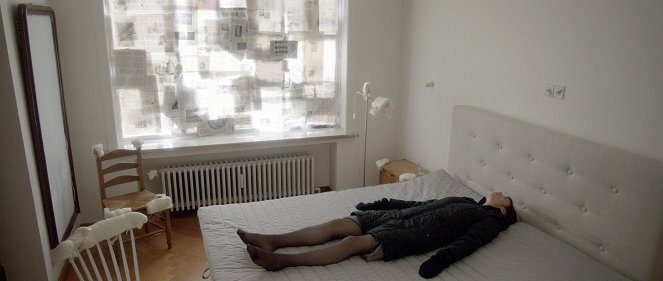Réalisation:
Lars von TrierScénario:
Lars von TrierPhotographie:
Manuel Alberto ClaroActeurs·trices:
Charlotte Gainsbourg, Shia LaBeouf, Stellan Skarsgård, Stacy Martin, Willem Dafoe, Jamie Bell, Connie Nielsen, Mia Goth, Sophie Kennedy Clark (plus)VOD (1)
Résumés(1)
Nymphomaniac est la folle et poétique histoire du parcours érotique d'une femme, de sa naissance jusqu'à l'âge de 50 ans, racontée par le personnage principal, Joe, qui s'est autodiagnostiquée nymphomane. Par une froide soirée d'hiver, le vieux et charmant célibataire Seligman découvre Joe dans une ruelle, rouée de coups. Après l'avoir ramenée chez lui, il soigne ses blessures et l'interroge sur sa vie. Seligman écoute intensément Joe lui raconter en huit chapitres successifs le récit de sa vie aux multiples ramifications et facettes, riche en associations et en incidents de parcours. (Les Films du Losange)
(plus)Vidéo (1)
Critiques (9)
La deuxième Nymphomane se maintient sur une forte vague d'unité pendant les deux premiers tiers et monte à des hauteurs risquées avec le "maître sadique K", provoquant ainsi un inconfort chez les spectateurs. Mais le dernier tiers, qualifié de "criminal", suscite des soupçons selon lesquels Lars ne savait pas comment conclure adéquatement et judicieusement le matériau déjà élaboré, ou qu'il s'était laissé abîmer par une production avide d'un maximum de fréquentation (l'absence de Shia LaBeouf dans le rôle de Jérôme, alors que tous les autres acteurs sont restés dans leurs rôles, laisse supposer que le dernier tiers a été tourné ultérieurement, après l'expiration de son contrat). En fin de compte, la dernière scène du film est une mauvaise blague, une gifle pour le spectateur avec un gant rempli de pièces de monnaie que la Nymphomane a gagnées en se divisant en deux parties. Trier y détruit complètement (et complètement inutilement) le personnage très important de Skarsgård pour l'histoire.
()
The second part of Nymphomaniac starts as boring to give you a punch in the gut at the ending. Shia LaBeouf delivers an excellent performance, and Stellan Skarsgård’s acting remains solid. All the actors are without reproach, actually. We even see more of Charlotte Gainsbourg instead of her younger self played by Stacy Martin. Charlotte makes quite an impression with her nipples, which I’ll probably never forget. You don’t get to see nipples as pert as hers in movies much, if you see them at all. What is worse, however, is that Lars von Trier continued his episodic, meaningless narration, which is boring in places, interesting in others and way too philosophical in yet other moments. And this keeps going on until the moment when Stellan convinces you of something you would be better not knowing. After these almost four hours, the ending is a blow to a soul of every feeling viewer. I’m giving this film one star because Lars filmed it quite skillfully. It can’t be denied that he’s a good director, but all the rest in this film is pure suffering.
()
My enthusiasm from the first Nymphomaniac can be summed up with the fact that I didn’t run to the cinema for the second part and waited for it without much interest for four months. And with similar lack of interest I spent two hours watching it, during which I looked at my watch more often that it would be healthy. There is something there, of course, Trier doesn’t make stupid empty stuff, and the climax is quite vibrant, but this time, the rules of his game didn’t work on me.
()
I have seen and am reviewing only the director’s cut of both parts of Nymph()maniac. For five and a half hours, the narrative about various methods of physical (self-)satisfaction, which is unsatisfying for viewers, confronts the two greatest themes of all Freudian directors – sex and death. The most striking merger of the two occurs during a drastic miscarriage, at the end of which Joe trembles with arousal, and in the chapter with the dying father, whose black-and-white picture and tone of emotional blackmail give such a (pseudo)artistic impression that it is most likely one of von Trier’s many tactics aimed at depriving viewers of what they want. In the course of both films, he employs a disturbing number of diversions, notional parentheses, jumps in time and changes in the style of the narrative in order to evoke a feeling of unease that makes it impossible to unobtrusively construct a story. The film brings to mind Zanussi with its hypermedia-style encyclopaedic layering of information, Buñuel with its thematisation of fetishes and unstable identity, Bergman with the intimate exploration of relationships, and Tarkovsky with its spiritual excitement (including a direct quote from The Mirror). Though this eclectic and intermedia compilation of styles is held together by the framework narrative, I would not call it a coherent form. How could there be a coherent film that is constructed as a dialogue between two seemingly incompatible worldviews (asexual and nymphomaniac) into which von Trier constantly tries to draw the viewer, whether by shattering visual taboos (I have never seen a more graphic depiction of abortion in a film) or by breaking down the fourth wall between fiction and reality (the camera reflected in a mirror, obvious parallels between the provocatively free-thinking views of Joe and von Trier himself). Despite all of the sexual explicitness and the extreme suffering of the female protagonist, the treatment of the female body seemed less exploitative to me than in, for example, Blue Is the Warmest Colour. Even though the woman becomes a sexual object several times, especially in the first part, and through most of the film her happiness depends on the man’s stamina, availability and abilities, her depiction elicits pain, compassion and disgust more frequently than pleasant feelings. In this context, the most beneficial scene of the director's cut may be the aforementioned abortion, which, with an openness that I believe will be particularly unpleasant for men, demonstrates throughout both films the intensified forms of defending a woman’s right to decide what she does with her own body. Showing us what we do not want to see is closely connected with consideration of that which we do not want to think about. In my opinion, such a provocation makes sense, like Nymph()maniac as a whole. 75% for part I, 80% for part II.
()
(Volume I)… which settles down a bit in the second half, when the forced overlaps disappear, and the director returns to his favorite theme of "woman as evil incarnate." This makes the film less long-winded but then comes Bond, 3+5, and golden rain, and the awkward impressions are broken even more than in Melancholia; please shrink the Director's Cut to two hours and without the asexual sex, though that's not really the point here (unexpectedly, right?).
()
Photos (26)
Photo © Zentropa Entertainments



Annonces